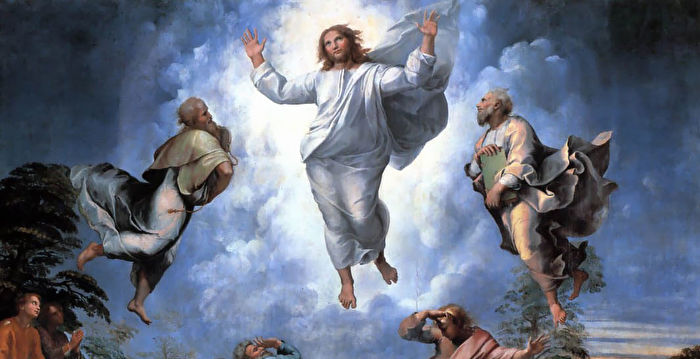Art Exhibition Documentary
Author: Zhou Yixiu
Part of Raphael’s Transfiguration. (Public domain)
In Rome, Raphael’s only competitor was Michelangelo. But this competition is mild, and even the modest Raphael has benefited a lot. He imitated the character modeling of Sistine Chapel “Genesis” and achieved the “terribilita” (terribilita) (Note 4) that can compete with Michelangelo. Raphael was also an admirer of Da Vinci. From 1513 to 1516, Da Vinci happened to be in Rome. Raphael learned the smudge and dark background style from him; in addition, Raphael’s The depth of space and the effect of tragedy shown in the prints are affected by feelings.
3. Great decoration work in Rome
In 1508, Pope Julius II called Raphael to Rome to decorate many rooms in the Vatican Palace. The workload was so huge that Raphael had not completed it until his death in 1520. Finally, his young assistants Penny and Romano Assist in completion.
How can Raphael lead the creation of such a huge mural? In addition to being familiar with the techniques of mural painting, it is also necessary to select the most suitable assistant and assign work. Raphael first conceives various scenes, and after repeated considerations to draw up the composition, he conducts exercises based on the complete composition, including the whole picture sketch and some partial character exercises, and then the assistant or apprentice reproduces the final composition on the wall (Note 5 ). Assistants will also participate when drawing, but in order to maintain quality and overall consistency, Raphael must strictly monitor.
In 1513, Leo X succeeded Julius II to ascend the pope’s throne. At this time Raphael was at the peak of artistic creation, and the new pope appointed him to continue to lead the work of decorating the room. Beginning in 1514, Leo X commissioned him to design ten tapestries of saint stories for the Sistine Chapel, and three tapestries for the Pope’s ritual bed, including a magnificent image of God in the center. In 1516, Raphael was ordered to design the balcony on the side of the Holy See Palace. He designed an ancient style decoration for this large corridor, decorating scenes in the Bible story with lace made of mud and peculiar shapes. frame. In addition to the Vatican, Raphael also provided many designs for other palaces and cities. For example, he designed antique decorative murals for the villa of the banker Agostino Kigi (Note 6) with the theme of the little Eros and the story of Saiji. .
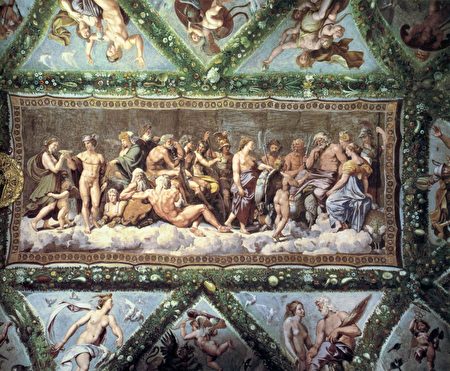
After Bramantier’s death, Raphael succeeded the construction director of St. Peter’s Basilica; the following year (1515) he assumed the supervisory officer of the excavation of ancient Roman ruins. He once wrote a letter suggesting that the Pope should make a catalogue of the monuments of Rome. The Vatican City has a collection of high-quality ancient Greek and Roman art and cultural relics. Because of his job position, Raphael was able to observe and refer to the artistic essence of the previous civilization from the ancient relics; his work team also benefited from it.

Many sketches of ancient cultural relics by Raphael and studio members were exhibited at the exhibition site, as well as the composition of group portraits of antique figures by Penny and Romano. Compared with the artistic styles of Leonardo da Vinci and Michelangelo, Raphael focused more on pursuing ideal classical beauty, including color coordination, elegant shape, and balanced composition. It was regarded as an advocacy of classicism by later generations. By.
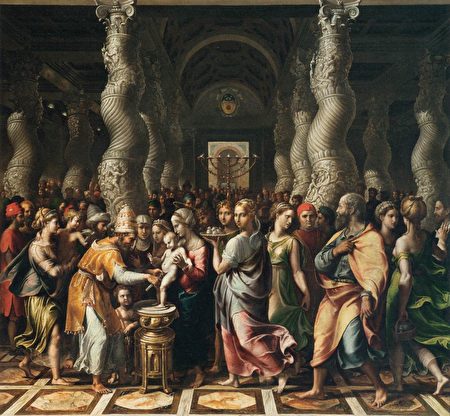
4. A large portrait of the Virgin at maturity
Even though Raphael’s last few years were mainly devoted to huge decorative paintings and large architectural projects, he never gave up private consecrated paintings or religious works representing the Virgin and Child, and Saints. This is the form of painting that he made his fortune in Florence, and as a result he found a more powerful patron of Rome. Most of his paintings of the Virgin are inspired by Leonardo’s “Santa Ana”, which is the theme that Leonardo continued in his later years in Rome. Raphael learned from the monumental character arrangement and the harmony of the shape, and can change a lot of composition from several characters.
Raphael’s paintings of the Virgin are comparable to the master Leonardo da Vinci he admired in terms of the elegance and beauty of the figures and the richness of expressiveness. He added the child’s innocence and joy, the love of the Virgin, Saint Anna or St. Joseph’s thoughtful, melancholy look. In addition, Raphael also made various attempts at the scenes, sometimes in the rigorous framework of a classical architecture; sometimes immersed in the warm tones of dusk—especially in his late works.
These Madonna paintings are so popular that they are dubbed various aliases, such as “The Madonna of Divine Love”, “The Madonna of the Oak Tree”, “The Madonna of the Rosary”, “The Madonna of the Pearl” and so on. After the nineteenth century, art historians retained the quality of these paintings, but they did not focus on Raphael’s ideas. The exhibition will display these paintings as a collection, which is also conducive to comparing and clarifying the various factors of creation, and defining the creative methods of these young apprentices and Raphael in their later years.
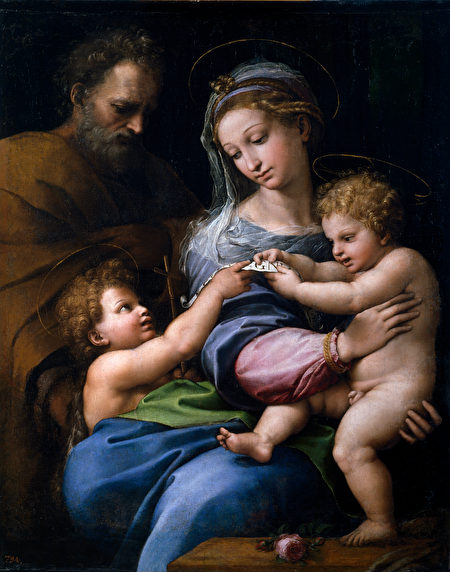
5. Gifted students-Giulio Romano (Giulio Romano)
Raphael’s student, Giulio Romano, was born in Rome (1499 to 1546) and was an Italian painter and architect. Compared with the classical style of the Renaissance, Romano’s art is considered to be a manneristic style of the late 16th century.
Romano became the main assistant of Raphael’s studio at the age of 16. He has good sketching skills and rich experience. He participated in almost all the steps in the case that Raphael took: from the preparation of the draft sketch, the final thick cardboard fine sketch to the formal drawing, he was guided by Raphael; But his outstanding personality quickly differentiated his painting style from Raphael.
Romano is so enthusiastic about ancient cultural relics and sculptures that he emphasizes the silhouette and three-dimensionality of people in his paintings. He also likes to describe buildings in Roman ruins. He emphasized the postures and expressions of the characters, sometimes exaggerated to the point of comics. Sometimes I like to add a warm family plot to interior paintings, and add fog and light to landscape paintings. After Raphael’s death in 1520, Romano and Penny inherited Raphael’s studio together and took over the unfinished work plan. Romano directed the completion of the main murals and decorations of the Vatican Constantine Hall. , And works such as Transfiguration. But he did not hesitate to change some of the original ideas of the teacher after Raphael’s death. Romano’s passionate, exaggerated and fanciful personality, and his preference for the dramatic effects of the picture, make the composition often crowded and restless, which is very different from the solemn and steady classical temperament of Raphael. Later, he went to Manduwa to develop and served as the Duke of Gonzaga (Federigo Gonzaga). Between 1524 and 1534, he renovated the Palazzo del Te (also translated as “German Palace”). The “Demise of the Giant” is Among the most famous murals. Manneristic style also spread to northern Italy.
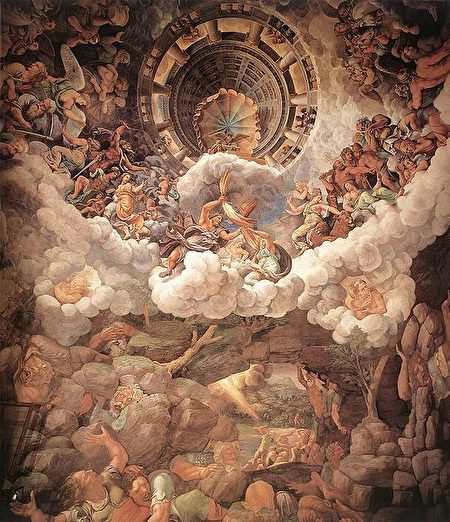
6. Faithful Assistant—Gianfrancesco Penni
Gianfrancesco Penni (Note 7) was born in Florence in 1492 in a family of weavers. He met this young future master before Raphael went to Rome. Soon Penny also followed Raphael to Rome and entered his studio. Penny has a lot of work in the studio, so he got the nickname “fattore”, which means “different”. However, Raphael would especially let him complete more difficult things, such as a complete sketch of a composition.
He collaborated with Raphael Studio on murals in many famous halls in the Vatican, as well as projects in Villa Farnesina, Rome and other places.
After Raphael’s death, Penny and Romano continued to complete Raphael’s unfinished work, such as the Hall of Constantine, Transfiguration and the Coronation and Ascension of the Virgin (the Assumption and Coronation of the Virgin, 1525).
Penny also renovated the Vatican Conference Hall (Sala del Concistoro, dedicated to the Pope’s convening of Cardinals) for Clement VII, and provided a tapestry design of the “Story of the Life of Christ”. In 1526, he left Rome for Mantua (Romano had already arrived in Manchester in 1524). However, according to Vasari’s records, he did not receive a good reception in Mantua (although he had worked with Romano in the Palazzo), so he soon sought his own development, passing through Lombardy, Rome and Naples. . In 1528, Penny died in Naples.
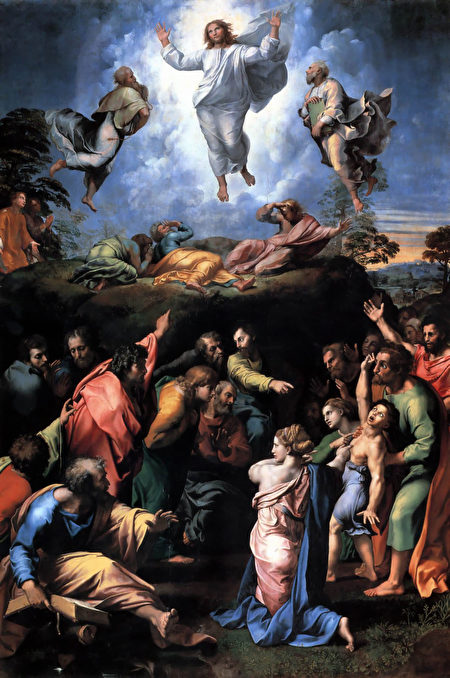
7. Raphael, a master portrait painter
From the very beginning of his career, Raphael has received many commissions for portraits, with clients ranging from the Grand Duke of Ubino to the middle class of Florence. From his first series of portraits, it can be seen that Raphael attaches great importance to the realism of the characters, so he highly praises the realism of Flanders and the method of presenting the characters, because this method allows the person in the painting to directly communicate with the audience. He took his teachers Perugino and Leonardo as models, especially Leonardo’s “Mona Lisa”, which combines northern naturalism and Italian idealism, and is Raphael’s most admired painting.
After arriving in Rome, Raphael quickly became a hot portrait painter. He painted not only the portraits of two popes, but also the family members of the popes, and many cardinals. Although these portraits are more traditional, Raphael still adds monumental, authoritative, and great power representations, and he will match the scenes for these dignitaries according to the characteristics of different characters. For example, he used a gloomy sense of authority to represent the Cardinal of Biberna; for the portrait of the Medici family (Note 8), he matched the luxurious green flannel, and for the Princess of Naples, he matched the gorgeous background of the court. However, Raphael’s most moving portraits are portraits of relatives and friends around him. These paintings are full of simplicity and friendship, rather than power and wealth. The backgrounds of most portraits are deep and heavy, but Raphael makes the pictures full of spirituality and vitality with his friendly expressions and unique personalities. This style of expressing the inner strength of the characters in a simple way may be influenced by the Venetian painters Giogioni, Titian or Sebastian. The solid sketch and sweet sensibility are the unique skills of Raphael. The Renaissance theorist Alberti advocated that portraits should “let the lack be revealed” and be fully displayed in Raphael’s portraits.
One of the most beautiful works in the exhibition is Raphael’s La Donna Velata (La Donna Velata), which is said to have been made by Raphael for his beloved lover. The woman is affectionate, with one hand on her chest, implicitly conveying her loyal love. The silky gold-line clothing, the intricate and delicate pleats, the delicate face and skin show that Raphael is extremely dedicated to this painting.
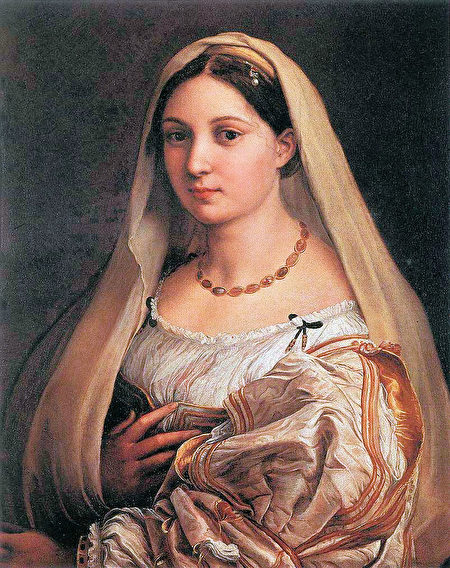
Also on display are Baldassare Castiglione, a diplomat and friend of Ubino, Bindo Altoviti, a sponsor and friend of Florence, and Lorenzo II of the Medici family. A portrait and portraits of students Penny and Romano. Raphael’s characters are vivid. The description is meticulous and not rigid. Raphael’s color is clean but rich, and the color is translucent. For example: Atoviti’s golden hair has a rich and real texture, dense and scattered. It still “breathes” clearly and naturally in the dark areas with low contrast, and the color is golden yellow. The color of cheeks and the corners of the mouth is rich, natural and harmonious.
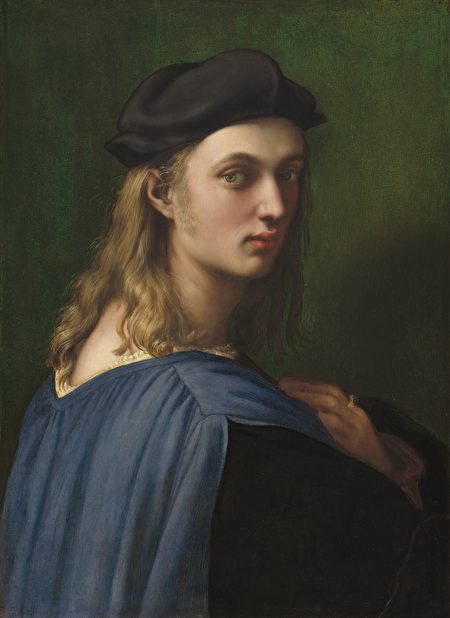

The last work in the exhibition is a double bust portrait of Raphael and his protégé Romano. This painting was painted between 1519 and 1520 and belongs to the late Raphael works. The style of painting is similar to the portrait of Baldassare Castiglione, but the layout is more vivid and lively. Two-person portrait painting was quite popular at the time, and it could express the relationship between the characters in the painting. In the painting, Raphael is on the back, with a hand on Romano’s shoulder in the front; his position (status) is higher, and he looks directly at the audience and communicates directly with the audience, which also means his subjectivity as a master ; And Romano, as an apprentice, looked back at the teacher with a humble expression, but pointed his hand forward (there may be a mirror, but Raphael reflected in the mirror), which seemed to imply that he was inherited from Raphael. Raphael put his hand on Romano’s shoulder calmly and confidently, which seemed to represent trust and affirmation, and at the same time seemed to declare to the world that Romano was his successor.
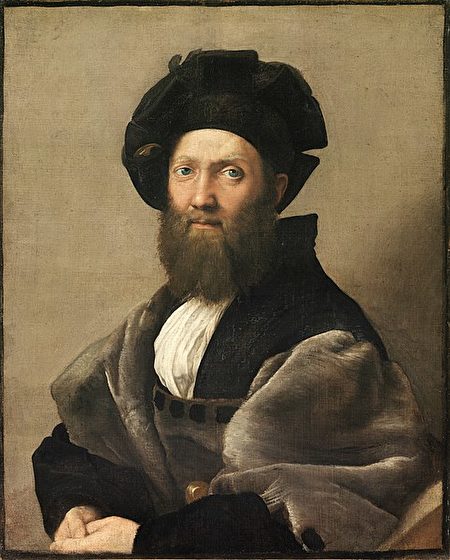
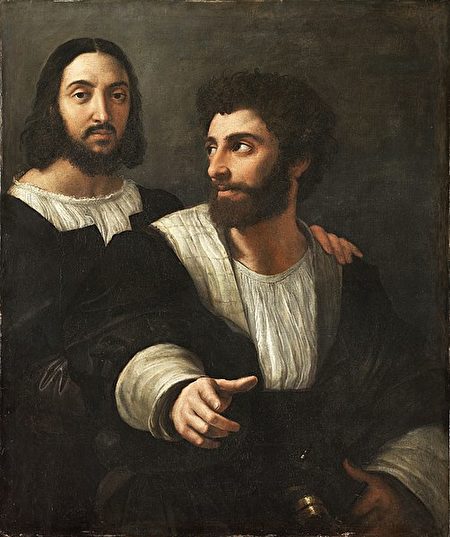
However, from another perspective, the vivid posture of the young Romano shows his enthusiasm, but it also reveals his restless character. He doesn’t seem to accept Raphael’s opinions passively, and Raphael’s attitude is relatively conservative here.
In any case, Raphael is willing to let Romano be in the main position in the center, occupying most of the area of the frame, which has already made people feel Raphael’s generosity to the backward. The audience also learned from the exhibition that Raphael is different from Michelangelo, insisting on completing the overall critical mentality all by himself, unlike the strong personal style of Rubens Studio. After Raphael conceived the picture, he still gave the studio members a lot of room to play. Of course it does not mean that Raphael does not require quality in his works. He knows the lack of apprenticeships, but he still tolerates, supports and encourages these young artists. Perhaps because Raphael’s personal strength is limited, he is willing to let more people work together to achieve a greater cause.
Raphael passed away shortly after finishing this work, so this painting just confirms Giulio Romano’s important status as the heir to Raphael’s art. The exhibition ends with this two-person portrait with a strong heritage, which is very meaningful. @
Notes:
Note 4: The Italian word terribilita is used to describe the “strong will and great power of anger” revealed in Michelangelo’s works.
Note 5: The general habit is to first draw the artwork on a large cardboard, then use an awl to pierce small holes along the outline, cover the artwork on the wall, and pour toner on the small holes to transfer the outline to the plaster Mud wall surface.
Note 6: Agostino Andrea Chigi (1466-1520) was born in Siena and later moved to Rome. He was a banker and mine owner in a wealthy country during the Renaissance in Italy. He has funded many popes and cardinals, and generously supported artists, including Perugino, Udine, Romano, Piombeau, Sodom, and Raphael. A mansion was built on the banks of the Tiber River, which was later named the heir, the famous Villa Farnese.
Note 7: Gianfrancesco Penni (1492-1528), also known as Giovanni Francis, was an Italian painter. His brother Bartolommeou was a Tudor artist of Henry VIII, and his brother Luca Penni was an artist who worked at the School of Fontainebleau when Francis I of France.
Note 8: Such as the Grand Duke of Ubino, Lorenzo Medici.
——Reproduced from “Art Talk Artium”
(Click to view[Art Talk]series of articles)
(Check out the[Raphael Raffaello Sanzio’s Last Years]series of articles.)
Editor in charge: 李梅#
.
